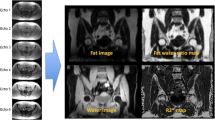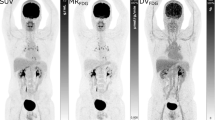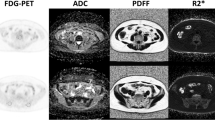Abstract
Objectives
The objective of the study was to determine age-related changes occurring in red marrow with regard to its distribution and the degree of its metabolic activity by whole-body 2-deoxy-2-[F-18]fluoro-d-glucose (FDG)-positron emission tomography (PET).
Methods
This retrospective study included 112 patients (56 male, 56 female, mean age 40 years, range 2–85) who underwent whole-body FDG-PET scans for assessment of disorders that were determined not to affect red marrow activity. These patients were categorized into the following groups with equal gender distribution: 0–15 years (12 individuals), 16–25 years (20), 26–35 years (10), 36–45 years (20), 46–55 years (14), 56–65 years (16), 66–75 years (14), and 76–85 years (6). Whole-body FDG-PET images were performed at 60 min after the intravenous administration of 0.14 mCi/kg of FDG. By employing a dedicated whole-body PET scanner. Maximal standardized uptake value (SUVmax) was calculated from three consecutive transverse sections of the upper thirds of the humeri and femora, manubrium of the sternum, 12th thoracic and 5th lumbar vertebra and anterior superior iliac crests of the pelvis. All available results from other imaging examinations [magnetic resonance imaging (MRI), computed tomography (CT), and conventional radiolography], laboratory data, biopsies, and the clinical course of these subjects were reviewed to make certain that the bone marrow sites examined were free of any known pathologies.
Results
SUVmax in the extremities showed significant decline with aging (correlation coefficient of −0.60 to −0.67, p < 0.01). In contrast, a weak correlation was noted in the axial skeletal activity with advancing age (correlation coefficient of −0.28 to −0.48, p < 0.05).
Conclusions
These data suggest that FDG metabolic activity of the red marrow in the extremities decline significantly with normal aging, while that of the axial skeleton show minimal decrease related to this biologic phenomenon. These findings are of value in assessing the effects of hematological and other disorders in the distribution and the metabolic activity of this important tissue and testing therapeutic interventions that are employed for treating such maladies.




Similar content being viewed by others
References
Zhao P, Liu W, Cui Y (2006) Rapid immune reconstitution and dendritic cell engraftment post-bone marrow transplantation with heterogeneous progenitors and GM-CSF treatment. Exp Hematol 34:951–964, Jul
Zhang Y, Adachi Y, Iwasaki M, Minamino K, Suzuki Y, Nakano K, Koike Y, Mukaide H, Shigematsu A, Kiriyama N, Li C, Ikehara S (2006) G-CSF and/or M-CSF accelerate differentiation of bone marrow cells into endothelial progenitor cells in vitro. Oncol Rep 15:1523–1527, Jun
Gazitt Y, Akay C, Thomas C 3rd (2006) No polarization of type 1 or type 2 precursor dendritic cells in peripheral blood stem cell collections of non-Hodgkin’s lymphoma patients mobilized with cyclophosphamide plus G-CSF, GM-CSF, or GM-CSF followed by G-CSF. Stem Cells Dev 15:269–277, Apr
Johnston KL, Farnen JP, Manske BR, Go RS (2005) Abnormal positron emission tomography (PET) scan secondary to the use of hematopoietic growth factors. Haematologica 90(12 Suppl), Dec
Blodgett TM, Ames JT, Torok FS, McCook BM, Meltzer CC (2004) Diffuse bone marrow uptake on whole-body F-18 fluorodeoxyglucose positron emission tomography in a patient taking recombinant erythropoietin. Clin Nucl Med 29:161–163, Mar
Brynes RK, McKenna RW, Sundberg RD (1978) Bone marrow aspiration and trephine biopsy: an approach to a thorough study. Am J Clin Pathol 70:753–759, Nov
Ellis LD, Jensen JN, Westerman MF (1964) Needle biopsy of bone and marrow: an experience with 1,445 biopsies. Arch Intern Med 114:213–214
James LP, Stass SA, Schumacher HR (1980) Value of imprint preparations of bone marrow biopsies in hematologic diagnosis. Cancer 46:173–177, Jul 1
Jamshidi K, Swaim WR (1971) Bone marrow biopsy with unaltered architecture: a new biopsy device. J Lab Clin Med 77:335–342, Feb
Knowles S, Hoffbrand AV (1980) Bone-marrow aspiration and trephine biopsy (1). Br Med J 281:204–205, Jul 19
Steiner RM, Mitchell DG, Rao VM, et al. (1993) Magnetic resonance imaging of diffuse bone marrow disease. Radiol Clin North Am 31:383–409
Federico M, Magin RL, Swartz HM, et al. (1989) Detection of bone marrow involvement in patients with cancer. Tumori 75:90–96
Alavi A, Kung JW, Zhuang H (2004) Implications of PET based molecular imaging on the current and future practice of medicine. Semin Nucl Med 34:56–69
Belhocine T, Spaepen K, Dusart M, Castaigne C, Muylle K, Bourgeois P, Bourgeois D, Dierickx L, Flamen P (2006) 18FDG-PET in oncology: the best and the worst. Int J Oncol 28:1249–1261, May
Kumar R, Nadig MR, Chauhan A (2005) Positron emission tomography: clinical applications in oncology. Part 1. Expert Rev Anticancer Ther (6):1079–1094, Dec 5
Wechalekar K, Sharma B, Cook G (2005) PET/CT in oncology—a major advance. Clin Radiol 60:1143–1155, Nov
Kazama T, Swanston N, Podoloff DA, Macapinlac HA (2005) Effect of colony-stimulating factor and conventional- or high-dose chemotherapy on FDG uptake in bone marrow. Eur J Nucl Med Mol Imaging 32:1406–1411, Dec. Epub 2005 Aug 31
Meyer MA, Nathan CA (2000) Reduced F-18 fluorodeoxyglucose uptake within marrow after external beam radiation. Clin Nucl Med 25:279–280, Apr
Kricun ME (1985) Red-yellow marrow conversion: its effect on the location of some solitary bone lesions. Skeletal Radiol 14:10–19
Hashimoto M (1962) Pathology of bone marrow. Acta Haematol 27:193–216
Dunnhill MS, Anderson JH, Whitehead R (1967) Quantitative histological studies on age changes in bone. J Pathol Bacteriol 94:275–291
Vogler JB 3rd, Murphy WA (1988) Bone marrow imaging. Radiology 168:679–693
Desai AG, Thakur ML (1985) Radiopharmaceuticals for spleen and bone marrow studies. Semin Nucl Med 15:229–238
Datz FL, Taylor A Jr (1985) The clinical use of radionuclide bone marrow imaging. Semin Nucl Med 15:239–259
Engstedt L, Franzen S, Jonsson L, et al. (1958) In vivo localization of colloidal Au198 intravenously injected in polycythemia vera: a preliminary report. Acta Radiol 49:66–71
Silberstein B (1998) Nuclear hematology: the erythron. In: Nucl Med Annual 163–174
Kim C, Reske S.N, Abass Alavi (1996) Bone marrow scintigraphy. In: Henkin R., et al. (eds) Nuclear medicine. By Mosby-Year book, pp 1223–124
Herbert CJ, et al (eds). (1996) Nuclear medicine: diagnosis and therapy. New York, NY: By Thieme medical Publishers, Inc., pp 780–784
Van Dyke D, Price D, Shkurkin C, et al. (1967) Differences in distribution of erythropoietic and reticuloendothelial marrow in hematologic disease. Blood 30:364–374
Hotze A, Low A, Mahlstedt J, et al. (1984) Combined bone marrow and skeletal scintigraphy in osseous and myelogenous diseases. Rofo 140:717–723
Blend MJ, Pavel DG (1986) Bone marrow imaging: a comparison study using a 99m Tc-sulphur colloid versus a new 99m Tc microaggregated albumin. Nucl Med Commun 7:787–789
Beamish MR, Brown EB (1974) The metabolism of transferrin-bound 111In and 59Fe in the rat. Blood 43:693–701
Bourgeois P, Demonceau G, Stegen M, et al. (1991) 99Tcm-HMPAO-labelled leucocytes for bone marrow scintigraphy and evaluation of skeletal lesions: comparison with 99Tcm-HSA colloid results. Nucl Med Commun 12:621–627
Duncker CM, Carrio I, Berna L, et al. (1990) Radioimmune imaging of bone marrow in patients with suspected bone metastases from primary breast cancer. J Nucl Med 31:1450–1455
Munz DL, Sandrock D, Rilinger N (1990) Comparison of immunoscintigraphy and colloid scintigraphy of bone marrow. Lancet 336:258–259
Reske SN, Buell U (1990) Reduced technetium 99m labelled NCA-95/CEA-antibody uptake in liver due to gentle antibody reconstitution: technical note. Eur J Nucl Med 17:38–41
Reske SN, Karstens JH, Gloeckner W, et al. (1989) Radioimmunoimaging for diagnosis of bone marrow involvement in breast cancer and malignant lymphoma. Lancet 1:299–301
Alavi A, Lakhani P, Mavi A, et al. (2004) PET: a revolution in medical imaging. Radiol Clin North Am 42:983–1001
Cheran SK, Herndon JE 2nd, Patz EF Jr (2004) Comparison of whole-body FDG to bone scan for detection of bone metastases in patients with a new diagnosis of lung cancer. Lung Cancer 44:317–325
Durski JM, Srinivas S, Segall G (2000) Comparison of GDF-PET and bone scans for detecting skeletal metastases in patients with non-small cell lung cancer. Clin Positron Imaging 3:97–105
El-Haddad G, Zhuang H, Gupta N, et al. (2004) Evolving role of positron emission tomography in the management of patients with inflammatory and other benign disorders. Semin Nucl Med 34:313–329
Shreve PD, Anzai Y, Wahl RL (1999) Pitfalls in oncologic diagnosis with FDG PET imaging: physiologic and benign variants. Radiographics 19:61–77
Author information
Authors and Affiliations
Corresponding author
Rights and permissions
About this article
Cite this article
Fan, C., Hernandez-Pampaloni, M., Houseni, M. et al. Age-Related Changes in the Metabolic Activity and Distribution of the Red Marrow as Demonstrated by 2-Deoxy-2-[F-18]fluoro-d-glucose-Positron Emission Tomography. Mol Imaging Biol 9, 300–307 (2007). https://doi.org/10.1007/s11307-007-0100-9
Published:
Issue Date:
DOI: https://doi.org/10.1007/s11307-007-0100-9




